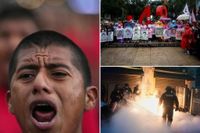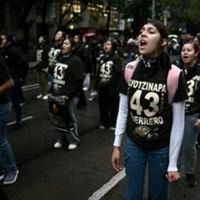On September 26, 2025, the heart of Mexico City throbbed with the chants of thousands demanding answers to a question that has haunted a nation for more than a decade: What happened to the 43 students who vanished from the Ayotzinapa Rural Teachers’ College in 2014? The annual march, now marking its eleventh year, drew roughly 3,000 protesters according to Milenio, underscoring the enduring pain and frustration of families, activists, and citizens alike.
The demonstration followed a 4.2-kilometer route from the Angel of Independence Monument along Paseo de la Reforma Avenue, culminating at the National Palace—its historic façade shielded by metal barricades. Authorities braced for unrest, closing streets and federal ministries, and guarding monuments against potential violence. As Mexico News Daily reported, the city was on edge, mindful of the anger simmering beneath the surface.
The story began on a night eleven years ago, on September 26, 2014, when 43 students from Ayotzinapa set out to Mexico City to commemorate the anniversary of the 1968 Tlatelolco student massacre—a political pilgrimage that had become a tradition in Guerrero. According to Court News, police opened fire on the students after they commandeered buses, then handed them over to the drug gang Guerreros Unidos. The students were never seen again. Only the burned remains of three have since been identified.
Authorities believe the students were killed by cartel members with ties to government and military officials, a suspicion that has only deepened public distrust. As Associated Press explained, the case quickly became a symbol of corruption, cartel violence, and the agony of the more than 133,000 disappeared people in Mexico. The number 43, along with the faces of the missing, now appears on monuments and graffiti throughout the capital—a silent, omnipresent reminder of one of Mexico’s greatest modern tragedies.
Despite dozens of arrests—including a former attorney general, local officials, military, and police officers—no one has been convicted. Many suspects were released due to procedural irregularities, while others remain on trial. The case was officially deemed a "state crime" in 2022, with prosecutors citing police collusion with Guerreros Unidos and complicity of local, state, and federal officials, including the military.
The families’ anguish was palpable at this year’s march. “After 11 years, the demand remains the same: their whereabouts; the truth, however painful it may be; and justice,” declared Hilda Hernández, mother of César Manuel González, in a video message inviting Mexicans to join the protest, as cited by Associated Press. Another parent, Clemente Rodríguez, father of Christian Rodríguez, lamented, “Governments come and governments go, but the case remains unresolved.”
President Claudia Sheinbaum, who met with the families on September 4, 2025, has repeatedly pledged to pursue “truth and justice.” She established a new investigative unit in March and replaced the special prosecutor on the case, but families left the meeting disheartened, insisting that progress had not just stalled—it had regressed. On September 26, Sheinbaum reiterated her commitment: “There’s a new special prosecutor … and we’re committed to doing everything possible to uncover the truth and provide justice.” Yet, for many, these words rang hollow against the backdrop of persistent impunity.
Frustration with the investigation reached a boiling point the day before the march. Protesters gathered at Campo Militar No. 1—a military installation notorious for its role as a clandestine prison during the 1970s “Dirty War”—and attempted to force their way in by ramming a cargo truck into the main gate, then setting it ablaze and launching fireworks at the walls. Riot police responded, and the scene turned chaotic. The parents, joined by supporters, demanded that the Federal Attorney General’s Office investigate the military’s involvement and release hundreds of classified documents believed to hold crucial information about the students’ fate.
Since 2022, families have pressed the armed forces to hand over these documents, but the military insists it has already shared all relevant information—a claim disputed by an Inter-American Commission on Human Rights investigative team. President Sheinbaum, for her part, maintains that the Army has complied, but skepticism remains high. As Mexico News Daily noted, the families’ belief in military involvement—either by omission or commission—has not been assuaged by the government’s assurances.
The international dimension of the case adds another layer of complexity. Tomás Zerón, the former head of the Criminal Investigation Agency who oversaw the initial investigation and was later accused of orchestrating a government cover-up, fled Mexico in 2019 and is now in Israel. Despite repeated extradition requests from Sheinbaum, Israel has refused to return Zerón, who faces accusations of abduction, torture, and tampering with evidence. Sheinbaum renewed her vow to pressure Israel for Zerón’s extradition, but so far, he remains beyond the reach of Mexican justice.
Meanwhile, two key members of Guerreros Unidos—Adán Casarrubias Salgado and Pablo Vega Cuevas—have faced justice in the United States, but not for their alleged roles in the students’ disappearance. Casarrubias Salgado, arrested in 2015 and extradited to the U.S. in 2022, was sentenced in March 2025 to eleven years for coordinating heroin shipments. Vega Cuevas, arrested in Oklahoma in 2014, walked free in August 2025 after cooperating with the DEA. Notably, neither man was questioned about the Ayotzinapa case, even though newly released DEA electronic intercepts show they exchanged messages about the violence that night—potentially holding key insights into the tragedy. Claire Dorfman of the National Security Archive called the lack of investigation into these communications “an example of prosecutorial tunnel vision,” pointing out that drug prosecutions continue to eclipse human rights concerns.
“If protecting human rights and having accountability and having justice be a priority aren’t considered prosecutable even in a case like this, then I don’t know when they ever could be,” Dorfman told Court News.
As night fell on Mexico City, the marchers’ calls for truth and justice echoed through the barricaded streets. Yet, for the families of the 43, the passage of time has only deepened the wound. The faces of their sons—still missing, still mourned—looked out from posters and banners, a silent testament to a story that refuses to fade.
While the government promises new investigations and international pressure mounts for extraditions, the fate of the Ayotzinapa students remains unresolved. The annual march is a reminder that, in Mexico, some wounds remain open, and some questions refuse to be silenced.


